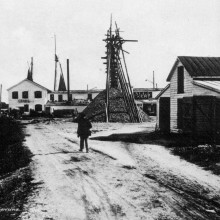History
The York River is arguably the most historically significant location for early colonial history found anywhere in America. European and Native American civilizations collided here. This was the land of Powhatan, Opechanacanough, Pocahantas, and the legendary explorations of Captain John Smith. No wonder this area’s colonial land patents (King’s grant lands) were so highly sought after by the first families of Virginia for the their Colonial plantations. The Washington’s, Lee’s, Anderson’s, Roane’s, Tucker’s, and Taliaferro’s settled its shores. History lives and breathes here. It is woven into the fabric of the estuary and its surrounding lands.
The Chesapeake Corporation & Sea-Rac Oysters
The Chesapeake Corporation, owners of the wildly successful pulp and paper mill at West Point, were an integral part of the York River economy since the early 20th century. The management of the mill had the foresight to continue investing in new technology in both good and bad economic times in order to constantly improve operating efficiencies. These investments kept the Chesapeake Corporation alive when similar Kraft mills were shutting down throughout the country.
However, when oyster populations started crashing throughout the Chesapeake Bay, the oystermen of the York River attempted to pin their failing fishery directly on the mill. They blamed the poor oyster harvests on the effluent released by the mill into the York River. The Chesapeake Corporation was deeply concerned about these claims. Oyster families such as the Richardsons and Roanes began aggressive litigation against the mill in an attempt to seek restitution for the loss of their livelihood caused by the demise of the natural oyster beds.
The Chesapeake Corporation responded by conducting experiments to attempt to prove the mill had nothing to do with the decline of the oyster beds in the York River. The Chesapeake Corporation put forth strong arguments in the courts that sedimentation due to erosion was the primary culprit. They also went on to show that baby oyster larvae need to attach themselves to existing oyster shells on the river bottom to successfully reproduce. The Chesapeake Corporation argued that because the overzealous waterman removed all the oysters they could with reckless abandon and did not return the shucked oyster shell to the river bottom, the oysters could not reproduce.
Eventually the excess sedimentation silted over the depleted beds and led to a massive reduction of successfully reproductive oyster rocks in the river. They rounded out their case with secondary arguments that predation and disease were furthering the problems for the oyster beds. The mill had made a very strong argument in their defense, and generally the courts tended to agree that the Chesapeake Corporation was not responsible for the oyster problem.This controversy deeply affected management at the mill. They were accustomed to being viewed as innovators, a vital part of the economy, and a job creator for the local area. They responded in 1936 by leasing river bottom on the York River and getting into the oyster business. At first, they were simply trying to determine whether oysters could be produced in commercial quantities while simultaneously using sound management practices. These oyster ground leases were purchased from the same oyster watermen who had unsuccessfully sued the company. The oyster division of Chesapeake Corporation began a series of experiments on these grounds using various oyster aquaculture techniques seen in Japan and New Zealand.
The company established in 1938 a wildly successful model oyster farm near Williamsburg at Queen’s Creek where they installed off bottom oyster trays in which they placed oysters to avoid siltation from the increasingly turbid York River water. Not only did this technique work, but the oysters were a sensation in the culinary community and were marketed as Sea-Rac oysters. These attractive oysters were grown individually and were regularly worked by men at low tide. Because of the exposure to the air the oysters were forced to exercise their abductor mussels by clamping shut until high tide would return. As a result, these same oysters were reported to successfully remain clamped shut after harvesting and shipment for upwards of three months! As such, the Sea-Rac brand commanded top dollar and its oysters were served at high end restaurants around the country.
Not until the U.S. Navy began establishing a presence in the same area as the Sea-Rac farm at Williamsburg was the Chesapeake Corporation forced to cease its Sea-Rac oyster farm. However, rather than quitting altogether, Chesapeake Corporation attempted to relocate the farm to the Rappahannock River but reported that the site chosen was not conducive to their farming operation. The Chesapeake Corporation officially exited the oyster farming business in 1941 but continued to sub-lease its private oyster grounds on the York to waterman until well into the 21st century.


